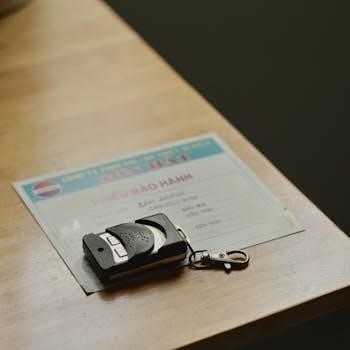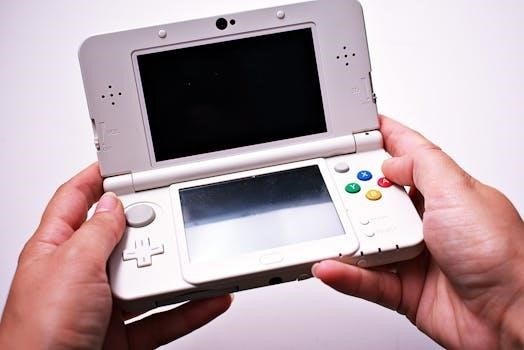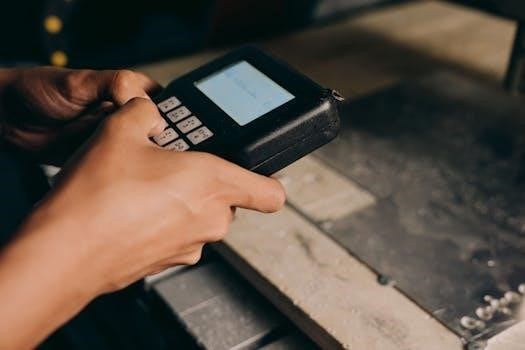solar charge controller user manual pdf
What is a Solar Charge Controller?
Solar charge controllers are essential components in photovoltaic systems. They regulate the voltage from solar panels to ensure batteries are charged efficiently and safely. These controllers prevent overcharging and extend battery life. They are available for various battery types.
What is a Solar Charge Controller?
A solar charge controller, also known as a solar regulator, is a vital component in any solar power system. It manages the flow of electricity from the solar panels to the battery bank, ensuring optimal charging and preventing damage. Without a charge controller, batteries can be overcharged, leading to reduced lifespan or even hazardous situations.
The primary function of a solar charge controller is to regulate the voltage and current coming from the solar panels. It acts as a buffer, preventing the higher voltage output of the panels from damaging the more sensitive batteries. Different types of controllers, like PWM and MPPT, employ various charging algorithms tailored to specific battery types, such as lead-acid, lithium, and gel.
Moreover, these controllers often incorporate features such as overcharge protection, deep discharge prevention, and reverse polarity protection, enhancing the safety and reliability of the entire solar power system. Understanding the role of the charge controller is crucial for efficient and long-lasting solar energy utilization.
User manuals provide essential guidance for safe and effective operation. They offer detailed instructions on installation, settings, and troubleshooting. Reading the manual ensures optimal performance and prolongs the device’s lifespan and safety.
Importance of Reading the Manual
Reading the user manual for your solar charge controller is extremely important. It helps ensure the device is installed and operated correctly. Understanding the manual prevents potential hazards and maximizes the controller’s lifespan; Manuals contain crucial information, including safety precautions, wiring diagrams, and troubleshooting tips. Ignoring these instructions can lead to improper operation, decreased efficiency, and even damage to your solar system components.
The manual provides details on compatible battery types, optimal charging algorithms, and load settings. It also explains how to interpret indicator lights and error codes. Following the recommended procedures ensures your batteries are charged safely and efficiently. This helps to avoid overcharging or undercharging, both of which can significantly reduce battery life.
Moreover, the manual outlines the manufacturer’s warranty terms and conditions. Operating the controller outside the specified parameters may void the warranty. Taking the time to thoroughly read and understand the manual is a worthwhile investment.

Understanding the User Manual
Key Sections in a Typical Manual
A typical solar charge controller manual includes several key sections. These sections are designed to guide users through installation, operation, and maintenance. The first section usually covers product specifications, detailing the controller’s voltage, current, and power ratings. This section also includes a list of compatible battery types and solar panel configurations.
Next, the manual provides detailed installation instructions, including wiring diagrams and safety precautions. This section often includes step-by-step guidance on connecting the solar panels, batteries, and loads to the controller. Clear diagrams and illustrations are essential for proper installation.
The operational instructions section explains how to configure the controller’s settings. This includes setting the battery type, charging algorithm, and load control parameters. Understanding these settings is crucial for optimizing battery performance and lifespan.
Finally, the manual includes a troubleshooting section, addressing common issues and providing solutions. This section also contains maintenance tips, such as cleaning the controller and checking connections.
Installation involves connecting solar panels to the controller, then the controller to the batteries. Ensure correct polarity. Secure connections are vital for efficient energy transfer and system safety.
Connecting Solar Panels and Batteries
Connecting solar panels and batteries to a solar charge controller requires careful attention to detail to ensure safe and efficient operation. Begin by identifying the correct polarity of both the solar panels and the batteries, usually indicated by plus (+) and minus (-) symbols. First, connect the battery to the charge controller, ensuring a secure and correct connection. The controller should then power on, displaying battery voltage.
Next, connect the solar panels to the charge controller, again verifying correct polarity. Once connected, the controller will regulate the voltage and current flow to the battery, optimizing the charging process. It is crucial to use appropriately sized wiring for all connections to minimize voltage drop and prevent overheating.
Always consult the user manual for specific instructions and wiring diagrams for your particular charge controller model. Double-check all connections before applying power, and regularly inspect the wiring for any signs of damage or corrosion to maintain a reliable and safe solar power system. Incorrect connections can damage the controller or the batteries.

Installation Procedures
Safety Precautions During Installation
Prioritizing safety during solar charge controller installation is paramount to prevent accidents and ensure a long-lasting, reliable system. Before commencing any work, disconnect all power sources, including solar panels and batteries, to eliminate the risk of electrical shock. Always wear appropriate personal protective equipment, such as insulated gloves and safety glasses, to safeguard against potential hazards.
Carefully read and understand the user manual to familiarize yourself with the specific safety guidelines and warnings for your charge controller model. Ensure the installation location is well-ventilated to prevent overheating and accumulation of flammable gases from batteries. Use appropriately sized and insulated wiring for all connections, and double-check polarity before connecting any components.
Avoid working in wet or damp conditions, as water can increase the risk of electrical shock. Keep children and pets away from the installation area to prevent accidental contact with electrical components. Regularly inspect wiring and connections for any signs of damage or corrosion, and address any issues promptly. Following these safety precautions diligently will minimize risks and ensure a safe and successful installation.

Operating Instructions
Proper operation ensures optimal performance and longevity. This section details load settings, battery configurations, and charging algorithms. Understanding these instructions is crucial for efficient solar energy management; Always consult your manual for specific guidance.
Load Settings and Configurations
Understanding load settings is crucial for maximizing the efficiency of your solar charge controller. These settings determine how power is delivered to connected devices. Many controllers offer multiple load modes to suit diverse applications. Common modes include dusk-to-dawn operation, timer-based control, and manual override.
Dusk-to-dawn mode automatically activates the load at sunset and deactivates it at sunrise, ideal for lighting systems. Timer-based control allows you to set specific on and off times, useful for appliances or irrigation. Manual override provides direct control, enabling you to turn the load on or off as needed.
Proper configuration involves selecting the appropriate mode and adjusting parameters like voltage thresholds and timer durations. Incorrect settings can lead to inefficient energy use or damage to connected devices. Always consult the user manual for detailed instructions and specific recommendations for your setup. Ensure compatibility between the load and the controller’s capabilities.
Battery Type Settings and Charging Algorithms
Selecting the correct battery type setting is paramount for optimal battery performance and longevity. Solar charge controllers offer settings for various battery chemistries, including lead-acid (flooded, gel, AGM) and lithium-ion. Each battery type has unique charging requirements, and using the wrong setting can lead to undercharging, overcharging, or even battery damage.
Charging algorithms are pre-programmed strategies that dictate how the controller charges the battery. These algorithms typically involve multiple stages, such as bulk, absorption, and float, each designed to optimize charging efficiency and prevent overcharging. The controller adjusts voltage and current based on the battery’s state of charge and selected battery type.
Consult your battery manufacturer’s specifications to determine the recommended charging parameters. The user manual will guide you through selecting the appropriate battery type and verifying that the charging algorithm aligns with your battery’s requirements. Incorrect settings can significantly reduce battery life and compromise system performance.

Troubleshooting and Maintenance
Troubleshooting solar charge controllers involves diagnosing common issues like connection problems and error codes. Maintenance includes regularly checking connections for corrosion, ensuring proper ventilation, and occasionally cleaning the unit to guarantee optimal performance.
Common Issues and Solutions
Common issues with solar charge controllers often include overcharging or undercharging batteries, which can be due to incorrect voltage settings. Battery sulfation is another frequent problem, stemming from prolonged undercharging. Load disconnect issues can arise from incorrect settings or faulty wiring. Additionally, overheating may occur due to inadequate ventilation or excessive current.
Solutions involve verifying voltage and current settings against battery specifications outlined in the user manual. Adjusting charging algorithms for specific battery types (sealed, GEL, flooded) is crucial. Implementing proper wiring practices and ensuring adequate ventilation can prevent overheating. Regular inspections for corrosion and loose connections are also necessary. If issues persist, consulting the manufacturer or a qualified technician is recommended. Using a multimeter to test voltages and currents can help pinpoint the source of the problem. Furthermore, keeping the controller software updated can address bugs and improve performance. Replacing faulty components, when necessary, ensures continued optimal operation. Lastly, understanding error codes displayed on the controller is vital for accurate troubleshooting.
Troubleshooting and Maintenance
Maintenance Tips for Longevity
To maximize the lifespan of your solar charge controller, regular maintenance is essential. Begin by periodically inspecting all wiring connections to ensure they are secure and free from corrosion. Clean the controller’s exterior with a soft, dry cloth to prevent dust buildup that can lead to overheating. Check the ventilation around the controller, ensuring it is unobstructed to allow for proper airflow.
Monitor the controller’s performance by observing indicator lights and reviewing error logs, addressing any issues promptly. Verify that the controller’s settings align with the battery type and charging parameters recommended in the user manual. Annually, conduct a thorough system check, including battery health and solar panel output. If the controller has a fan, inspect it for proper operation and clean it if necessary. Store the controller in a cool, dry environment if it is not in use. Following these maintenance tips will help ensure your solar charge controller operates efficiently and reliably for years to come.
